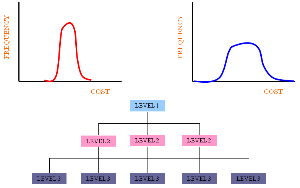Risk management - Risk assessment of a task part 2
Risk assessment of a task part 2
The diagram above tries to indicate, in the lower half, how you might break down a project into tasks at different levels.
Level 1, in this simple example, can be broken down into 3 tasks at level 2, then 5 tasks at level 3.
For each level the tasks are not necessarily equal in terms of complexity. One may be relatively easy whilst another, at the same level, could be much more complex to estimate.
How far do you drill down in terms of levels?
Obviously, one could go further and further until a task can not be broken down any more and you are left with a simple ‘work package’.
This would have the advantage of more accuracy when estimating the cost.
However, it will take a lot of time to get to this degree of accuracy.
If you are a contractor and trying to put a bid together, as quickly as possible, then there has to be a compromise.
If you are putting together the project schedule at the ‘planning’ stage then you would wish to adopt the technique of ‘horizon planning’ to save resource and time.
You need to make a judgement as the Project Manager as to the level of detail required for the bid in hand (for a contractor) or the level for horizon planning (for the main project).
For individual tasks we may have a very high confidence in the cost (narrow curve, for example material costs) or we may be a lot less confident (broader curve, for example research costs).
Naturally, we would like to put as much effort as possible in order to gain the most accurate assessment of the total cost for a bid situation.
In this case, we should be able to recognise that certain costs are quite accurate but others are a little more uncertain.
If this is the case, we should put the accurate ones to one side and concentrate on the less certain tasks.
This may involve more effort at, say, LEVEL 2, or a need to break down the task further to lower levels to gain more accuracy over the costs or duration etc.



